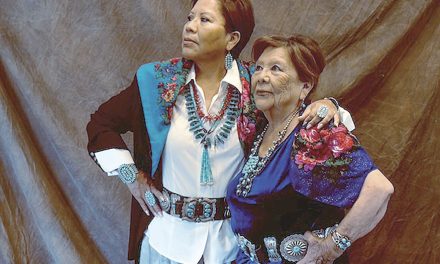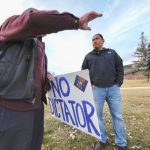
Delegates hear CARES Act money has not been spent
WINDOW ROCK
In a revelation shared with the Budget and Finance Committee last week by the offices of the controller and management and budget, the committee learned that not a dime of the $714 million in Coronavirus Aid, Relief and Economic Security Act monies allocated to Navajo from the U.S. Treasury Department had been spent.
This is because the OMB and controller have not received Navajo Nation government program budgets in a timely manner or at all, which would allow them to set up budget units and allow the controller’s office to disperse the funds.
“According to the controller, none of the money has been spent,” said BFC member Delegate Jimmy Yellowhair. Neither the president’s office, Speaker Seth Damon, BFC Chairman Jamie Henio or Vice Chairman Raymond Smith responded to a request for comment as of press time.
The responsibility of submitting budgets falls on the executive branch division directors and program managers who would be administering the CARES Act monies. The first allocation of more than $600 million in CARES Act relief funds to Navajo was made on May 5. “Until the budgets are set up we cannot charge the CARES money,” said Controller Pearline Kirk. “If there’s no budgets set up, there’s no expending occurring.”
Delegate Otto Tso, who sat in on the BFC meeting, said the Council did its job to appropriate the money. “They got the dollars and now the problem is those programs can’t spend it in a timely manner,” said Tso. “We put countless hours into these legislations to get money out to the programs, but they’re not expending and I don’t know why.”
Upon receiving the update, a directive was made by BFC to division directors and program managers to get the budgets set up for allocations of CARES Act funds and sent to OMB so that the controller can expend the monies.
‘Ninth hour’
To make matters worse, some of the appropriations for projects and services contained in the first round of bill No. 116-20 (CJN-47-20), approved by President Jonathan Nez on July 5, are set to expire on Aug. 31.
As a public service, the Navajo Times is making all coverage of the coronavirus pandemic fully available on its website. Please support the Times by subscribing.
How to protect yourself and others.
Why masks work. Which masks are best.
Resources for coronavirus assistance
This includes $10 million in food, water and basic necessities, $2 million for computer equipment for government offices, $3.5 million for bathroom additions, $3 million for PL 93-638 health facilities, and $2.5 million to improve the Nation’s procurement and financial system.
“It’s not looking good,” said Yellowhair. “Another legislation will have to be done.”
On July 4, Nez also approved $20 million in special duty pay, $10 million for personal protective equipment for frontline workers and $10 million for sanitizing government facilities in bill No. 132 (CJN-46-20), which was intended to be spent immediately.
This indicates that none of the money set aside for PPE and deep cleaning government buildings, including chapter houses, for the purpose of keeping employees and constituents safe, has been spent prior to the government reopening last week. Kirk said her office “can’t do anything” until budgets have been set up by OMB. She said she’s concerned about the $21 million in No. 116-20 that will “go away” by Aug. 31.
A representative from OMB reported that they had recently received CARES Act budgets from the controller ($2.5 million), Division of Community Development for bathroom additions ($3.5 million), and the Division of Pubic Safety for special duty pay ($20 million) and they were working on setting up the business units last week.
Kirk said in regard to the items that expire on Aug. 31, even if the budget units are set up immediately, there’s no guarantee the money can be spent by then. “If I don’t get a contract signed in the next nine days, I can’t pay the bill, so I can’t spend it,” said Kirk. Kirk said it’s one thing to put up the budget and it’s another thing to get contracts signed, goods and services delivered, and pay the bill by the 31st. “I don’t know if any of it can get spent,” said Kirk. “Here we are at the ninth hour.”
‘The practical side’
As far as other appropriations such as in No. 144-20 (CJY-67-20) that involve water, power line and broadband projects, Kirk is concerned as well. “A lot of these projects require sub-recipient agreements,” said Kirk. “It’s really tough for me if I don’t have the resources to put the agreements in place, but somebody’s got to monitor these projects and avoid audit finding situations.” She said her office has questions about whether or not the projects can be done by the Dec. 30 deadline.
“There’s a real possibility they will not get done,” said Kirk. Kirk said there are issues with securing workforce during the pandemic and many of the projects are work intensive. “If we started some project and they can’t finish, the question then becomes what do we do?” she said. “You can’t use CARES Act monies for unfinished projects.”
She questions whether entities like Navajo Tribal Utility Authority have the capacity to administer all of the CARES Act funds for their projects by the deadline. “I don’t think people realize the practical side of deploying these funds from our office,” said Kirk. “They’re restricted so we have to go through all of these internal controls and compliance matters.”
The CARES Act requires coronavirus relief funds be used to cover only those costs that are necessary expenditures incurred between March 1 and Dec. 30 due to the COVID-19 public health emergency, including addressing medical or public health needs and secondary impacts of the emergency, such as economic support to those suffering from employment or business interruptions due to COVID-19 closures.
No transparency
BFC Committee member Amber Crotty requested that revelations about unspent monies be shared in a press release from the speaker’s office “to inform the people,” but that never happened. “It’s very alarming,” said Crotty. “There’s really no transparency when it comes to this funding, which is what I’m really worried about.” She said per No. 115-20 (CMY-44-20), which established the Navajo Nation CARES Fund, there was supposed to be a public dashboard that details expenditures, but that web page has not been set up yet by the controller’s office.
“If we haven’t spent our money that was allocated in early July, we need a plan on how we’re going to spend this 714 million dollars,” said Crotty. Crotty lamented that a lot of time and energy has been devoted to where to spend the money, but not enough time to how the money would actually be expended.
“My presumption was that money had been spent and budgets had already been set up,” said Delegate Carl Slater, who told this reporter he had not been informed that no money has been spent. “We made the money available and it’s pretty infuriating to hear,” said Slater. “It really affects your ability to take seriously any future requests for funding, especially under the CARES Act.”
Tso said it’s not the fault of the Council if the executive branch can’t find a way to expedite their processes. “Usually they ask us for money, but now they have money and they can’t spend it,” said Tso. “It’s the internal process that lies within the executive branch. I really hope that the executive branch can spend these dollars because I’d hate for these dollars to be reverted.”
Tso suggested Council should call in the division directors and program managers for weekly progress reports on the CARES Act expenditures. “If programs are not spending it, the question should be, ‘Why are you not spending it?’” said Tso. “It’s their responsibility. Right now, I think we should just cut them off and do an equal distribution of money to our Navajo citizens who are enrolled and help them out directly.”
Tso said the way Navajo was allocated the initial CARES Act money was based on population, so why not do a direct disbursement, which would probably be quicker? “Every Navajo citizen is hurting in some way, whether on reservation or off,” he said. “We just need to get the money out to the Navajo citizens and they can choose how to spend it.”
Tso said with the timeline getting shorter and shorter, it’s really hard to consider giving additional monies to executive branch programs. “We don’t know if they’re going to expend these dollars,” he said. “I think we have to look at one plan to get the dollars out in a fast manner.”
‘There’s no plan’
Crotty said at the end of the day, it’s all about getting aid to the people. “I’m going to ask, what was the plan to implement what was passed in legislation?’” said Crotty. “Did they get organized to expedite this?” Five months into the pandemic, Crotty said she has still not seen an overall plan on how the Nation would comprehensively address COVID-19, which is something Council has been asking for from the president’s office and the Health Command Operations Center, led by Nez, since March.
“There’s no plan, no coordination,” she said. “We did not create a system that could maximize relief efforts for our people. What is going to happen when winter comes? We need to move on from trying to control how the money is spent to investing more time in actually spending it.”
Yellowhair requested an update from the BFC legal advisor about the status of U.S. Rep. Tom O’Halleran’s legislation requesting an extension for the tribal CARES Act expenditure deadline from Dec. 30 to Dec. 30, 2022, which might be the only hope of retaining all of the monies at this point.
According to the official U.S. Congress web page, the bill was referred to the House Committee on Oversight and Reform on July 9 and there has been no action on it since.








 Highway 264,
Highway 264, I-40, WB @ Winslow
I-40, WB @ Winslow